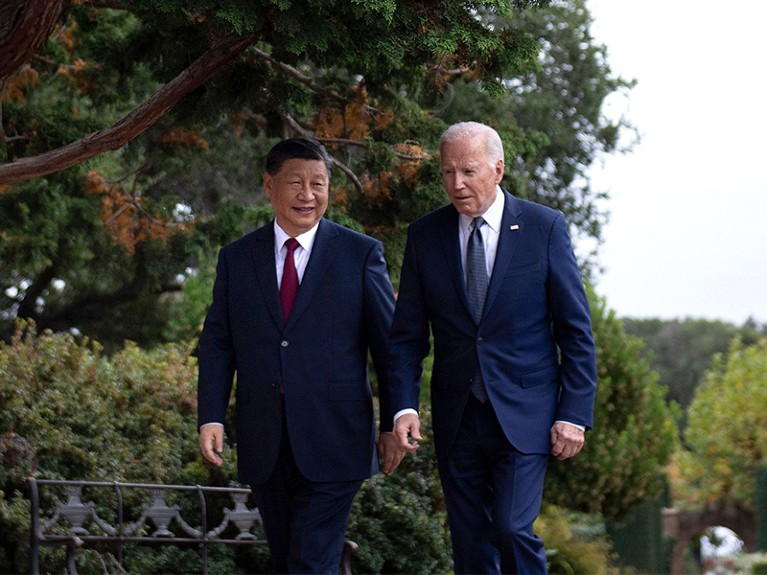
Chinese President Xi Jinping and US President Joe Biden met this month in California.Credit: Brendan Smialowski/AFP/Getty
It’s no secret that research collaborations between China and the United States — among other Western countries — are on a downward trajectory. Early indicators of a possible downturn have been confirmed by more sources.
A report from Japan’s Ministry of Education, Culture, Sports, Science and Technology, published in August, for instance, stated that the number of research articles co-authored by scientists in the two countries had fallen in 2021, the first annual drop since 1993. Meanwhile, data from Nature Index show that China-based scientists’ propensity to collaborate internationally has been waning, when looking at the authorship of papers in the Index’s natural-science journals.
Why is China’s high-quality research footprint becoming more introverted?
Nature reported last month that China’s decoupling from the countries loosely described as the West mirrors its strengthening of science links with low- and middle-income countries (LMICs), as part of its Belt and Road Initiative (see Nature 622, 669–670; 2023). There are many good reasons for China to be boosting science in LMICs, which could sorely do with greater research funding and capacity building.
But this is also creating parallel scientific systems — one centred on North America and Europe, and the other on China. The biggest challenges faced by humanity, from combating climate change to ending poverty, are embodied in a globally agreed set of targets, the United Nations Sustainable Development Goals (SDGs). Approaching them without shared knowledge can only slow down progress by creating competing systems for advancing and implementing solutions. It’s a scenario that the research community must be more aware of and work to avoid.
Nature Index offers some reasons as to why collaboration between China and the West is declining. Travel restrictions during the COVID-19 pandemic took their toll, limiting collaborations and barring new ones from being forged. Geopolitical tensions have led many Western governments to restrict their research partnerships with China, on national-security grounds, and vice versa. Shifting publication trends for researchers in China are also part of the mix.
Work by economist Richard Freeman and intellectual-property researcher Qingnan Xie, both at Harvard University in Cambridge, Massachusetts, has found that, between 2017 and 2022, US–China collaborations, as a proportion of all publications from China, fell by 5.4 percentage points (Q. Xie and R. B. Freeman NBER, 31306; 2023). China’s overall number of publications grew much faster than that of the United States during this period, so this drop was much bigger in volume terms than was the change in joint US–China papers as a proportion of US production — a fall of 1.9 percentage points from 2019 to 2022. Also during that period, the number of papers with just Chinese authors increased at a progressively steeper rate.
Collaboration decades
Another part of the story is that China’s researchers are no longer rewarded with promotions or bonuses if they collaborate or publish internationally, and are instead encouraged to focus on publishing in China-based journals. On one level, these trends give little cause for concern. China’s scientific prowess is established, and the country is engaging with new partners, bringing expertise and experience into the global science system. But the danger is that the international research ecosystem, underpinned by a centuries-old shared understanding of how knowledge is created, built and improved on through decades of global collaboration, splits into two.
China and California are leading the way on climate cooperation. Others should follow
There are some signs that such a divergence will not occur, and that scientific dialogue between China and the West is beginning to be rekindled. The meeting this month between US President Joe Biden and Chinese President Xi Jinping seemed to suggest a constructive approach to relations is returning. It took place in California, a state that in October signed a world-first agreement between a sub-national government and China with the aim of deepening collaboration on climate research and policy.
China has also been looking to work more closely with Europe. Officials, including Hou Jianguo, president of the Chinese Academy of Sciences in Beijing, toured the continent last month in a bid to improve ties.
Researchers are motivated through a mixture of incentives — one of which is to do what it takes to get on with the job. But researchers also operate in a larger context. In the words of the UN Human Development Report, the world is in “a new uncertainty complex”, and research is essential to the search for solutions. Both China and the United States need to build and work on shared initiatives such as the SDGs. Their twin paths ultimately need to become one.

 China and California are leading the way on climate cooperation. Others should follow
China and California are leading the way on climate cooperation. Others should follow
 China’s Belt and Road Initiative is boosting science — the West must engage, not withdraw
China’s Belt and Road Initiative is boosting science — the West must engage, not withdraw
 US extends science pact with China: what it means for research
US extends science pact with China: what it means for research
 China’s research evaluation revamp should not mean fewer international collaborations
China’s research evaluation revamp should not mean fewer international collaborations







